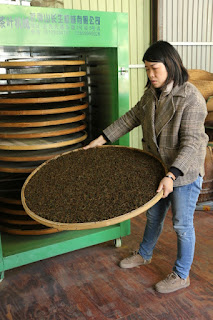It's the spring tea season again. While taking advantage of the free time, let me tell you the approximate timetable of our family's spring tea:
The time period from the end of the Chinese New Year to the beginning of March every year is the most leisure time for our family, because there is no tea business, and then the tea business has entered a small off-season, so we can really spend it in February. “Do whatever you want in life.”
Then from the beginning of March we will slowly enter the working state: such as cleaning the factory building, repairing the machines, implementing the workers, etc. Then around March 15th, normally,my husband is in Zhenghe County (Zhenghe County is 110 kilometers from Wuyi Mountain )processing white tea and my cloud-mist green tea.And then it will end around March 25th and return to Wuyi Mountain.
We then start processing our black tea around Qingming Festival. Except Tongmu Lao Cong black tea, most of our Lapsang Souchong and Jin Junmei will be processed before April 15th.
Since white tea, green tea, and black tea are all picked from relatively tender tea buds for processing, most of them can be directly sold after processing, except for a small part of black tea. For example, wild black tea and Laocong black tea need further refinement: such as picking tea stems.
The Wuyi rock tea in our family is usually picked before and after the Grain Rain, and then ends around the beginning of summer (this process is just to pick the fresh leaves from the tea tree and then process it into Mao cha, this process is just the primary production stage we call), and then from the middle of May, we entered the refining stage of Wuyi rock tea:First, the Mao cha sorting, and then the start of charcoal roasting. Our charcoal roasting workshop usually starts around June 5th, The charcoal of a baking pit can normally last for 16 days . Then, after a round of fire, we will relax for a few days, and continue to start the fire. This cycle of work continued until a month before the Chinese New Year, than we stop roasting work .
My husband's Guangdong Chaozhou Phoenix Dancong, the in-laws, will start picking Milanxiang dancong around the Qing Ming Festival and end by picking Ba xian at the end of April (Milanxiang is the earliest variety, and Baxian is the late variety) In all it takes about a month to complete the production of the variety (this month is also the same as the rock tea in Wuyi Mountain completed the initial production stage). Then followed by sorting, the refining process of charcoal roasting occurs. The quantity of Dancong tea of my husband’s family is relatively small, and it is only about 300 kilograms of refined tea processed in a month, so they will be refined faster. Generally, we will have new dancong is on sale around the mid of May.










































